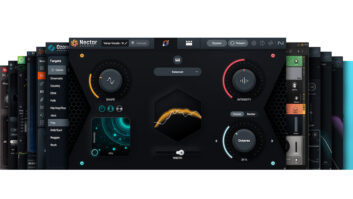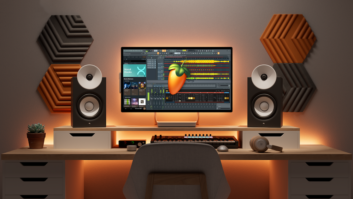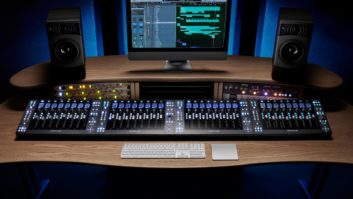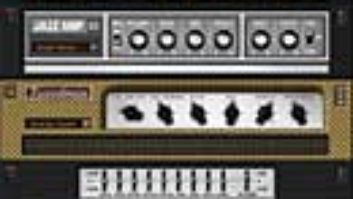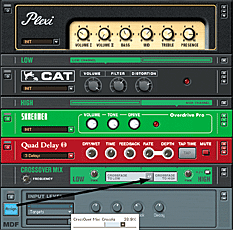
Native Instruments introduced Guitar Rig in 2004 into the field of guitar-processing software products that feature vintage amp sounds and effects. Guitar Rig 2 provides so many new programming concepts that you need to start tweaking your upgrade in a new way because there’s gold in there.
Crossover mix adjustment in the stomp box hybrid patch
SPLIT PERSONALITIES
If you haven’t yet made friends with the Split module, now’s the time. Split has always been great for generating variations of the basic sounds by parallel-processing two different effect chains and recombining them, allowing you to set the mix for a custom tone or control that mix with the pedal. A variation on this is the new Crossover Mix module, which acts like Split but also divides the signal into frequency bands that you can then mix back together.
Try creating a stomp box hybrid patch. Drag the crossover mix into the rack and set the crossover frequency to about 450 Hz. Bring in the Cat and Skreamer distortions, placing the Cat after the low crossover mix unit with a medium filter setting, and put the Skreamer after the high unit, with both tone and drive up. We’re going for really chuggy low strings and bright, articulate higher ones, or the smooth lead sound of a neck pickup’s tone, which Skreamer is quite good at. At this point, panning out the crossover mix even a little produces a kind of double-track effect, which is cool, but let’s keep this as organic as possible, so pan them back to center. Now drag any of the delays into position after the Skreamer (but before the crossover mix) so that muted picking and low chords get less of the delay effect, while high strings and leads receive a good amount.
Next, assign the new Rig Kontrol pedal to the crossfade slider so you can change the tone during sustaining sounds. But now that you’re sweeping between them, it again sounds like two distortions combined instead of one. So drag the Plexi amp into position before going parallel (before the low module) with fairly low gain so that there will be a constant baseline drive tone that will mix with both of the stomp boxes. Much better, but not entirely cohesive, as the tonal difference between low and high sounds is still too great from pedal-up to pedal-down. So click on Rig Kontrol’s Edit button and limit the range so that both are always mixed somewhat (never 100-percent low or high). The result is a big, fat, unified sound, even when you’re controlling the crossfade slider with the pedal while you play.
CONTROL ISSUES
The new MDF (modifiers) menu lists serious controller modules, including LFO, envelope, step and analog sequencers, and input level. Let’s pounce on that input level and see if we can modulate the stomp box hybrid patch’s crossover mix crossfade with playing dynamics. Drag it into the rack (modifiers don’t care where) and assign it to the crossfade by dragging the assign field over to the slider. Now it’s already happening: Light picking produces more of the Cat sound and heavier strokes bring in the Skreamer. But again, if the movement from low to high seems too great or too obvious, then click the target popup and lower the amount to 40 percent and then play with the offset parameter to fine-tune the range. Now the pedal still controls the basic crossfade amount and your picking style produces tones below and above it.
Input level is useful in general. You can use it to modulate simple parameters such as amp drive gain to make the amp models more dynamic. Modulate a parameter like reverb mix with a negative amount of input level, and soft playing adds more ‘verb while louder picking produces drier notes that “speak” more clearly.
WAFTS AND SURGES
Guitar Rig 2’s other modifiers are also potent. Try using the LFO with a slow sine wave to modulate parameters and keep the harmonics moving. One of my favorite targets is the wah wah pedal, something I call the “wafting wah.” Assign the LFO to the wah slider (pedal) and set the fader in a tonal region that you like. The trick here is to limit the depth of the modulation so that the effect is subtle. (Use the target popup.) I use 5 to 10 percent set at a medium rate, but wafting is quite personal, so experiment. The envelope module can be used in many ways, but I like setting up a really long attack time and assigning the envelope to an amp drive gain.
It’s like building your own compressor effect; let’s call it “the surge.” Drag in the envelope along with distortion, set the distortion knob to 0 and turn up the volume and tones. Then assign the envelope to the distortion knob. Tweak the trigger threshold to correspond to the part you are playing and then try out some chords — now you’re surging. The sequencers are great for music that really synchs to drum patterns. You can program accents that kick up the amp volume or drive gain on important beats so your playing really locks in or so that your power chords contain the same rhythmic information. Again, use the target amount and offset control to fine-tune the effect.
DIG IT!
The system’s GUI is so compelling that many users happily create sounds without digging too deeply into its programming. Guitar Rig’s modules can be installed in any order you like, so you can get “out of the box” and inventive really quickly.
Gerry Basserman is a composer/producer based in the San Francisco Bay Area.
